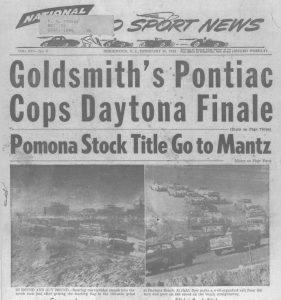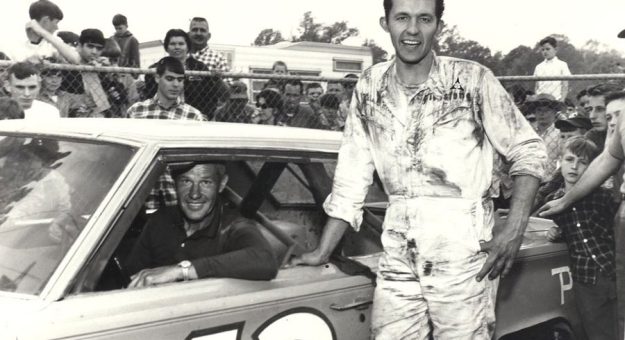Editor’s Note: NASCAR is celebrating its 75th anniversary in 2023. SPEED SPORT was founded in 1934 and was already on its way to becoming America’s Motorsports Authority when NASCAR was formed. As a result, we will bring you Part 11 of a 75-part series on the history of NASCAR as told in the pages of National Speed Sport News and SPEED SPORT Magazine.
While construction of the Daytona lnt’l Speedway was in its early stages, Paul Goldsmith’s dramatic victory over Curtis Turner in the final race on the Daytona Beach sand and asphalt race course marked the ending of NASCAR’s formative years.
Jack Senn’s Jan. 1 column described the early construction activity near U.S. Route 92 in Daytona Beach. Crews were cutting and burning brush and trees in preparation for bulldozers, which would shape Bill France’s long-awaited “tri-oval.” A scale model at the Speedweeks office on Broadway in Daytona Beach revealed plans for an elongated oval with a slight bulge on the north side.
Forty-foot wide straightaways and 47-foot wide turns banked at 31-degree angles would be visible from any of the five grandstands, each named for a notable Daytona Beach speed star: Sir Malcolm campbell, who sped along the beach straightaway at 276 mph, Barney Oldfield, Ralph DePafina, Sir Henry Segrave and Ray Keech. The grandstands were designed to hold 17,000 fans.
“In addition, there is room for more than 50,000 spectators in the infield,” said Bill France in the May 7 issue. He went on to estimate the cost of the speedway at $800,000 with another $100,000 in costs expected to arise from the construction of speedway offices and NASCAR national headquarters.
Automobile Manufacturer’s Association Returns To NASCAR
Among NASCAR writers, speculation raged about the return of the Automobile Manufacturer’s Ass’n to racing.
The Jan. 8 and 15 issues of NSSN reprinted Max Muhleman’s articles from the Charlotte (N.C) News, which reported NASCAR drivers Cotton Owens and Pat 0’Connor tested for Pontiac and United States Auto Club driver Jim Rathmann was building stock cars in his Miami, Fla., shop with new Chevrolet engines.

Chrysler debuted its new 390-horsepower 300D which seemed ideal for stock car racing. This, combined with doubts raised by some former factory drivers, such as Tim Flock, about racing without team support, led Muhleman to conclude that one month before Speedweeks, many questions about the 1958 NASCAR season remained unanswered.
More than 35,000 people lined the 4.1-mile beach-800-road circuit to watch Goldsmith lead the field along the Atlantic Ocean from start to finish. Yet, 150 yards from the finish, sand thrown up from the course obstructed Goldsmith’s view through the windshield of his 1958 Pontiac and he missed the last tum.
This mistake gave Turner the possibility of passing his partner in the lumber brokerage business for the historic victory. But Goldsmith nosed the black Pontiac into a sand bank and back onto the track in time to maintain his lead and capture the final race on the beach-road course by five lengths.
Meanwhile, Lee Petty, lost the battle on the beach, but his sixth-place finish moved him into the Grand National point lead. Petty padded his lead a week later with a victory in Concord, N.C., and went on to capture four more races in his home state, plus the New Oxford, Pa., event and the first Grand National feature in Toronto, Ontario.
On the year, his seven crowns and 44 top-10 finishes propelled him to his second championship.
Richard Petty’s Early Days
Petty’s title run set a good example for his oldest son Richard, a NASCAR rookie.
Richard raced for the first time on July 12 in a Columbia, S.C. convertible race. He drove his soon-to-be famous No. 43 car to a sixth-place showing. One week later, he finished 17th in his first Grand National race in Toronto.
As Richard Petty entered his first NASCAR fray, veteran driver Glenn “Fireball” Roberts continued to amaze NASCAR fans with his domination of the selected Grand National races he entered. Although the fanner Seabreeze (Fla.) High School and University of Florida right-handed pitcher entered only 10 of the 50 races on the schedule, Roberts led more laps than any other driver for the second consecutive year.
His six triumphs combined with nine top-10 finishes, earned the 29-year-old $36,845 in winnings and Pro Athlete of the Year honors from Florida sportswriters. NASCAR’s five national divisions featured three repeat champions, including Petty. Bob Welborn, in fact, won his third consecutive convertible division title while Ned Jarrett was the sportsman king for the second consecutive year.
New Yorker Johnny Coy earned the midget championship and Budd Olsen of New Jersey was the modified titlist.
Finally, by October work on Daytona Int’l Speedway had progressed to the point that paving could begin on the 2.5-mile track. Asphalt would be laid on top of the lime-rock base of the circuit, which surrounded the 45-acre Lake Lloyd, which was dug to provide dirt for the speedway’s banks.
Two months later, drivers were eagerly anticipating testing on Daytona Int’l Speedway.
An article in the Dec. 17 NSSN predicted Bill France’s revolutionary banked design would enable drivers to set world records in NASCAR and USAC-sanctioned events scheduled for the speedway’s initial year.
